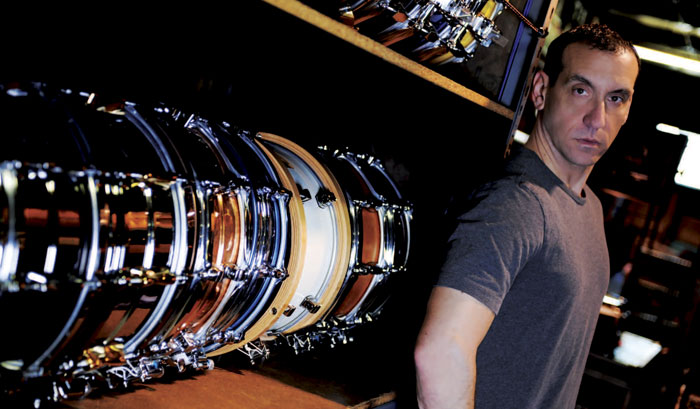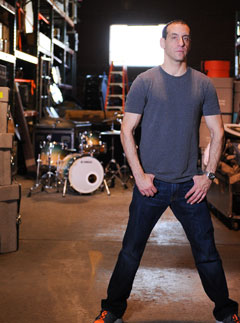


MIKE SHAPIRO HAS BEEN FIELDING THE SAME question for decades: How did a funky drummer from Washington, D.C., become one of the busiest players in the Brazilian music scene?
"I got very fortunate," says Shapiro, who grew up playing jazz, R&B, and go-go, the swinging funk style that blossomed in D.C. during the '80s. "I moved to L.A. with an R&B band looking for a deal, but wound up playing with a group out of Santa Barbara, where the great Brazilian percussionist Airto Moreira and his wife, vocalist Flora Purim, lived."
Purim heard Shapiro and was drawn to his playing, even though he'd had no Brazilian music experience. "I didn't know a thing about it," admits Mike. "But I was intrigued, so I approached it with the curiosity of a child. Airto started working with me. We had two drum sets opposite each other, and I would just try to mimic whatever he played. I was so hungry that I was willing to do whatever it took to play this music."
Everything was considered in developing the Phoenix kit: finishes, colors, resonance, bearing edges. They're on a whole new level.
Before long Shapiro was rehearsing with the band, and then touring and recording with them. "Working with Airto opened to door to working with Sergio Mendes," says Mike. "That in turn opened the door to working with many great Brazilian musicians: Dori Caymmi, Ivan Lins, Toninho Horta, Caetano Veloso."
Shapiro has recently been performing in a quintet with legendary trumpeter/producer Herb Alpert and Alpert's wife, vocalist Lani Hall, plus bassist Hussain Jiffry and pianist Bill Cantos. A recent tour produced the disc Herb Alpert & Lani Hall Live: Anything Goes, which features imaginative jazz- and Latin-infused readings of such standards as "Fascinating Rhythm" and "That Old Black Magic."

Shapiro says he relished the experience of arranging and performing all those classic songs. In fact, song and melody tend to be foremost in Mike's mind when approaching new material. "Arrangements are like pyramids to me," he says. "At the top is the melody and the lyric, if there is a lyric. Everything else is a matter of figuring out how to serve those things. I'm not saying that drummers take a back seat to melody instruments--we can do so much with so little. But it often comes down to that old adage: Less is more."
Onstage and in the studio, Shapiro prefers Yamaha drums. In fact, he was one of the players the company consulted while developing the new PHX (Phoenix) kit, along with such heavyweights as Dave Weckl, Paul Leim, Tommy Aldridge, and Ralph Humphrey.
"Everything was considered in developing the Phoenix kit," says Mike. "Finishes, colors, resonance, bearing edges. It was really great to be included in that process. And when I got my final production kit, my jaw absolutely dropped. They're on a whole new level. I wish I didn't have to say it that way, because it sounds like an advertisement. But it's true."
Now Shapiro uses a PHX as his primary studio kit. "It has an 8x12 rack tom, a 14x13 floor tom, and a 20x18 bass drum. The snare is a model I prototyped with Yamaha, which will eventually be available as the Mike Shapiro Signature Snare. It's a 14x6, ten-ply birch drum that's wonderfully versatile. It has great crack to it, and a good old-fashioned ping that never gets fatiguing. It's plain wood and doesn't use any particularly expensive parts, so it'll be available at a very reasonable price. It's a real working player's snare."
Meanwhile, Mike has been using a hybrid drum/percussion kit for the Herb Alpert gig. "I started out with a Yamaha Rick Marotta Hipgig kit, but with a microphone mounted in the bass drum. I use basically the snare drum, rack tom, and bass drum, and where the floor tom was, I have a little custom-built percussion table." Small percussion instruments rest on the table, hang from booms, or rest on the floor. "I might play sidestick with one hand and shaker or bell with the other," explains Mike. "I use a variety of mallets and sticks and triangle beaters."
As the Alpert gig indicates, Shapiro isn't strictly a "Brazilian" player. "I never lost my love of R&B, jazz, or rock," he insists. "But if you have to get typecast into a style, Brazilian is a great one, because it's got everything: There's a classical component, particularly the influence of Debussy and Ravel in the writing of Antonio Carlos Jobim and other composers. It's African. It's roots music for the people. Brazilian music is beautifully complex. It's incredibly simple. It's fantastic. I've been able to make a living playing some of the most beautiful music ever written. It's been a wonderful, wonderful ride."
(Photography Credit: Rob Shanahan)
























